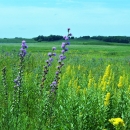About Us
Agassiz National Wildlife Refuge was established in 1937. Its primary purpose was to be a refuge and breeding ground for migratory birds and other wildlife. The refuge is located in northwestern Minnesota in the aspen parkland transitional zone between the tallgrass prairie to the west and the coniferous forest to the east. Open water and freshwater marshes occupy 37,400 acres of the refuge. Extensive areas of trees, shrubs and grasses are found on an additional 24,100 upland acres. The refuge is a total of 61,500 acres of wildlife habitat. In 1976, 4,000 acres in the northcentral portion of the refuge were designated as wilderness and are managed under the National Wilderness Preservation System. This area is one of the most westerly extensions of black spruce-tamarack bogs in Minnesota. The refuge is a designated as a Globally Important Bird Area and is a key breeding ground for 17 species of ducks in addition to being an important migration rest stop for waterfowl. The refuge is home to two resident packs of gray wolves as well as moose, nesting bald eagles and in the past had been noted for hosting one of the largest Franklin’s Gull colony in the United States.
Our Mission
The mission of the National Wildlife Refuge System is to administer a national network of lands and waters for the conservation, management and, where appropriate, restoration of the fish, wildlife and plant resources and their habitats within the United States for the benefit of present and future generations of Americans.
The purpose of Agassiz National Wildlife Refuge is to serve as a refuge and breeding ground for migratory birds and other wildlife.
Every national wildlife refuge national wildlife refuge
A national wildlife refuge is typically a contiguous area of land and water managed by the U.S. Fish and Wildlife Service for the conservation and, where appropriate, restoration of fish, wildlife and plant resources and their habitats for the benefit of present and future generations of Americans.
Learn more about national wildlife refuge was created for a special purpose. Some were created to protect migratory birds, others to protect threatened or endangered species or unique habitats, while others fulfill another special purpose. All activities allowed on refuges must be evaluated to make sure each activity will not conflict with the reason the refuge was founded.
Our History
March 23, 1937 – The refuge was established by President Franklin D. Roosevelt as a refuge feeding and breeding ground for migratory birds and other wildlife.
1961 - Initially founded as Mud Lake Migratory Waterfowl Refuge, the name was changed to Agassiz National Wildlife Refuge for the vast, ancient body of water—Glacial Lake Agassiz—that produced the exceedingly flat terrain characterizing the area today.
1976 – 4,000 acres in the northcentral portion of the refuge were designated as wilderness and are managed under the National Wilderness Preservation System.
1992 - After a 30-year absence, bald eagles once again began nesting on Agassiz National Wildlife Refuge.
Other Facilities in this Complex
In addition to the main refuge, staff at Agassiz National Wildlife Refuge also manage two units of the Northern Tallgrass Prairie National Wildlife Refuge and a 510-acre Waterfowl Production Area.
Northern Tallgrass Prairie National Wildlife Refuge was established in 2000 to address the loss of America’s grasslands and the decline of grassland wildlife. This refuge encompasses all or part of 85 counties in western Minnesota and northwestern Iowa.
The units managed by Agassiz National Wildlife Refuge staff are located in Kittson County. These tracts of land are aspen parkland habitat, which is a transitional zone between the coniferous forest and tallgrass prairie habitat.
The Walton Waterfowl Production Area was purchased in 2012 using Federal Migratory Bird Hunting and Conservation Stamp dollars. The stamp, commonly known as the Duck Stamp is what waterfowl hunters are required to have in their possession while hunting. This property provides nesting habitat for a variety of waterfowl, grassland birds and other wildlife. This property also helps reduce erosion, clean and protect ground water and reduce flooding
